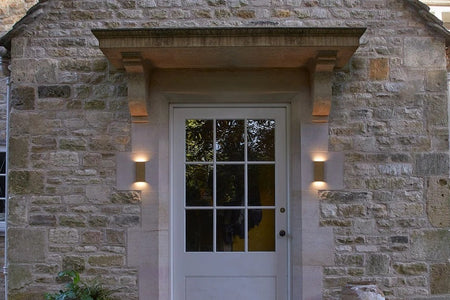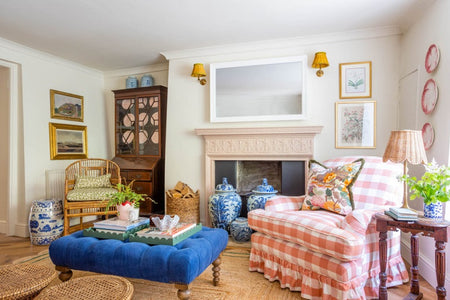
The festive season means a flurry of temporary interior redecoration. But why exactly do we like to fill our homes with red and greens and whopping great trees in December? Here’s a little Pooky history of Christmas decoration – plus some lighting tips to give your home a festive glow…
The holly and the ivy (and the apples)
If there are two colours that we associate more than any others with Christmas, they must be red and green. While these colours certainly have strong centuries-long religious connotations – The Holly and the Ivy sets these out very clearly – we actually have the ancient Romans to thank for the practice of decorating the house with red and green during the last month of the year.On 17 December, they celebrated the feast of Saturnalia, in honour of the god, Saturn, whose mythological reign was seen as a golden age of abundance and peace. The Romans could rarely have too much of a good thing and Saturnalia feasting was gradually extended for a further five days, culminating on 23 December.

They decorated their houses with bright red holly berries and the boughs of evergreen trees, on which were placed small pottery or wax figurines called sigillaria. Decorating with red and green in the dark of December became so popular that it would survive the fall of the Roman Empire and cross religious boundaries…
In the Middle Ages, the story of Adam and Eve, the apple, and the Tree of Good and Evil featured in The Paradise Play, performed in midwinter. Apple trees were barren in winter, so churches were decorated with pine trees hung with apples that had been stored since autumn—a practice that, over time, was carried over into people’s homes. So, when you put up your Christmas tree and decorate it, you’re following a very long tradition.
Cromwell: Christmas is cancelled...
That said, celebrating Christmas with anything that smacked of pagan traditions became an absolute no-no for Oliver Cromwell and the Puritans; the Commonwealth period marked the beginning of a decline in England’s Christmas festivities. The ban on Christmas crossed the Atlantic too...

1659 public notice banning Christmas celebrations, Boston, USA. Public domain.
The Industrial Revolution played its part too; long hours, harsh conditions and low pay meant that there was little time and even less money to spend on Christmas. While Christmas traditions managed to cling on in some rural areas, it was not until the first half of the 19th century that things began to look up again for Christmas in the UK—thanks, largely, to the efforts of two men: Charles Dickens and Prince Albert…
The Victorians save Christmas!
In A Christmas Carol, published in 1843, Dickens achieved the impossible; he can be said to have reinvented Christmas, making it once more “a good time: a kind forgiving, charitable pleasant time.”
 Mr Fezziwig’s Ball, A Christmas Carol by Charles Dickens, 1843; illustrated by John Leech. Public domain.
Mr Fezziwig’s Ball, A Christmas Carol by Charles Dickens, 1843; illustrated by John Leech. Public domain.
Meanwhile, the decorated Christmas tree, not to mention the originally pagan celebration of Yule, had long been a popular tradition in Germany, which had largely escaped the extremes of England and America’s Puritan clampdown. It was a tradition that Prince Albert brought with him when he married Queen Victoria in 1840; Windsor Castle would have its very first Christmas tree and the country’s first Christmas cards appeared in the 1840s.

Queen Victoria, Prince Albert, and their children admire the Windsor Castle Christmas tree, 1848. Public domain.
Across the Atlantic, a similar post-Puritan Christmas tree revolution had been under way since the 1830s, thanks to the arrival of many thousands of German immigrants. America’s German communities popularised not only the tree itself but also the practice of adding simple homemade decorations, such as strings of popcorn, paper chains, and ornaments—and gingerbread houses. In return, the USA has given the world red and white striped candy canes, Christmas tree lights, snow globes, Christmas cookies, and that perennial favourite, Bing Crosby, Rosemary Clooney, Danny Kaye, Vera-Ellen et al in White Christmas.

American candy cane promotional card by William B Steenberge (1844-1922). Public domain.
For most of the 20th century, here at home, as well as away, however, non-edible Christmas decorations of all kinds—some of which would survive two world wars—were carefully put away for another year. For decades one Christmas would look very much like another; the same tree-topping fairies would be dressed and redressed.
In the latter part of the 20th century, however, change was afoot; dressing your home for Christmas became a favourite subject for home and lifestyle magazines and supplements and Christmas decorations would become very big business indeed…
The 21st century Christmas
 Let there be light—festive family room by @littleedwardian, featuring Pooky’s Artemis chandelier.
Let there be light—festive family room by @littleedwardian, featuring Pooky’s Artemis chandelier.
These days our houses are more Christmassy than ever. A survey from 2019 found that Britons were willing to spend an average of £185 per year on decorations, while 40% had two Christmas trees (although we’re still not in the same league as the Abu Dhabi hotel that hung £7m worth of diamonds, rubies and other bling on its tree).
But while the red and green tradition endures, today’s Christmas decorations are as varied and diverse as could be imagined. Pretty much anything goes: if you’re into timeless maximalism, you can fill the house with every colour under the sun. If you’re more of a minimalist, you’re probably happier with a neutral palette, cream candles and natural greenery, an ideal Japandi Christmas. If you prefer pure Scandinavian, the traditional colours of red and green, as well as snowy white, will strike a festive chord.
One of the most popular contemporary decorations is the Christmas wreath, which, like the gingerbread house, had its beginnings in Germany. Originally a simple combination of holly and ivy, today’s Christmas wreaths can take many forms, come in many colours and materials, and are now as likely to be found indoors as well as hung on front doors.
Above all, Christmas is the time to decorate in a way that you love and in a way that is warm and welcoming and projects a sense of good cheer. Here are a few lighting tips to inspire you…
Christmas lighting inspiration…
Change your lampshades for festive colours
Switching around your lampshades is one of the easiest and most effective ways to transform the feel of a room. Pop your usual shades in storage for the festive season and temporarily replace them with some warm reds, greens and golds.
 Straight empire shade in scarlet tapers hand painted card
Straight empire shade in scarlet tapers hand painted card
Make strategic use of cordless table lamps
Rechargeable lamps have opened up all sorts of new lighting opportunities, since you can literally put them anywhere with no need to worry about sockets and extension leads. Create cosy nooks around the house, highlight your Christmassy corners and shelves, and plonk one in the middle of the festive table for instant atmosphere.
 Designer Laurel Chick uses a Pooky Phileas rechargeable table lamp on a shelf to create a cosy corner. Image: @laurelchick
Designer Laurel Chick uses a Pooky Phileas rechargeable table lamp on a shelf to create a cosy corner. Image: @laurelchick
Reflect candlelight
Craftily position candles and tealights next to mirrors (for example, on the mantelpiece) for a lovely double twinkle effect. Or better still, get a candleholder with a mirrored surface, such as the Celeste (see more candleholders here.)

Celeste wall mounted candle holder in antique brass
For more festive lighting tips, see Five clever ways to use lighting to make your home cosy for Christmas.
Browse Pooky's blog for more interior design inspiration, and look through our huge range of lights, shades candles and more here.
Image top: Simple, understated, but undeniably festive… Christmas garland by @prettylittleedwardian and with Pooky’s Hydra lantern reflected in the over-mantel mirror.











